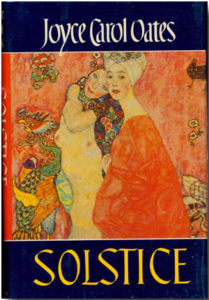
Solstice
By Joyce Carol Oates
249 pages
Originally published in 1985; reissued in 2019 by Ecco
Joyce Carol Oates is nothing if not a prolific writer. She published her first book in 1963 at age 25, and has since published 58 novels, a number of plays and novellas, and many volumes of short stories, poetry, and nonfiction. She is noted not just for her immense literary output, but also for her range of genres and styles.
Solstice, first published in 1985, was her 16th novel. I found a copy of that edition in a box in the garage of our home in Nicaragua. It had an alluring cover. I had read only two other novels by Oates and didn’t love either of them. They were smartly written with a nod toward literary experimentation here and there, but I found the stories themselves very ordinary, almost banal. I don’t think I would have given Oates another try, except that some years ago I was in a museum in NYC and I bumped into her, literally bumped into her as we were each looking at the same painting. I apologized. She smiled and said something about the painting, as if we were sharing some little secret. She is a small, fragile-looking woman. I thought, “How can she hold a full-time teaching job and write so many novels?”
Solstice is a quick read. It’s the story of Sheila Trask, a reasonably successful painter (and local celebrity) and Monica Jensen, a beautiful, young, and recently divorced woman that has just come to a small New England town to get away from a short, ill-fated marriage. The two women are very different. Trask is willful, dark, and impulsive. Jensen is compliant, self-reflective, and careful. What begins as a very ordinary, teenage-type infatuation with an older, successful woman moves to something deeper and more exciting and then to something obsessive and nearly fatal in less than a single year.
Reading it, I was trying to figure out whether a story about a clandestine lesbian love affair could have been, in and of itself, a literary experiment. (Oates is known for experimental writing.) I don’t know. I didn’t bother to research that.
But it doesn’t matter. Solstice is about something more challenging that that – something that perhaps one could not writeabout today. I see it as an investigation into the possibilities of lesbian love: Can the conventional patterns and conflicts that are almost universal in heterosexual relationships be avoided in homosexual (in particular, lesbian) ones? To put it in more contemporary terms, it is a novel that explores the dynamics of intersectionality and hierarchy within a lesbian love affair. It is a story, as one critic put it, that puts Hemingway on his head. It is a story of Women Without Men.
Indeed, Sheila Trask has virtually all of the power in the relationship because she stands way above Monica in the power hierarchy. She is older, richer, more successful, and more self-confident. Monica comes into the relationship offering youth, fragility, availability, and remarkable physical – i.e., feminine – beauty.
There is much exchanged in the relationship, each giving the other and taking from the other what she can. In the beginning, Sheila is clearly dominant and uses that dominance to manipulate the relationship to go where she wants it to go. But eventually, Monica, by maintaining her feminine strengths and vulnerabilities, acquires the power.
That’s how it reads to me. You may have a different view. It’s a weekend’s read. If anything said above intrigues you, I can recommend it.
Critical Reviews
* “A powerful beam into the dark places of the soul.” (New York Times)
* “Oates’s novel is spellbinding, entrancing reading.” (West Coast Review of Books)
Interesting Facts:
* In addition to all the writing she’s done, Joyce Carol Oates was a teacher at Princeton for more than 40 years.
* She has won numerous literary awards, including the 1973 O. Henry Award (for “The Dead”), the 1996 Bram Stoker Award (for Zombie), the 1996 Penn/Malamud Award for Excellence in the Art of the Short Story, and the 1970 National Book Award for Fiction (for them).
This is how I remember her…

 MarkFord
MarkFord